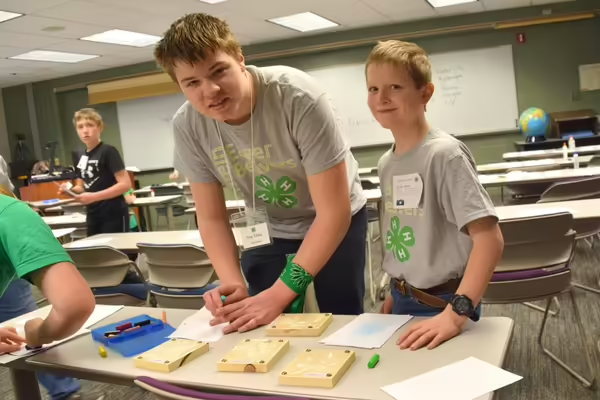
This past February, 120 youth from Fulton, Mason, Peoria and Tazewell counties gathered for a day of hands-on learning at 4-H Clover Clinic, an event designed to introduce youth to various skills and interests. But behind the scenes, it’s the dedicated team of teens who serve in leadership roles who bring the program to life.
4-H Clover Clinic offers a series of workshops led by knowledgeable instructors, that cover topics such as paper quilling, kitchen science, woodworking, and needle felting. While these workshops provided engaging opportunities for younger members, the 15 teenage 4-H members left a different kind of impression on the younger participants and even the adult instructors.
“Throughout the day, I interacted with teens as they taught classes, checked in with instructors, delivered water and/or missing supplies, engaged with kids who were feeling overwhelmed and hesitant, and had fun helping with the projects,” explained Anita Wilkinson, Illinois Extension program coordinator and 4-H Clover Clinic instructor. “The four teens who volunteered in the same class as I, each taught part of the lesson and talked about their leadership roles within the 4-H program. They left a lasting impression on all of the kids in our classes.”
Teen leaders are essential in ensuring the event runs smoothly, but their contributions go beyond logistics. They serve as mentors and role models, encouraging and guiding younger 4-H members. Many of these teens once attended Clover Clinic as participants and now enjoy giving back to the program that helped spark their own interests.
For many teens, taking on a leadership role at Clover Clinic is an opportunity to develop important life skills, such as communication, teamwork, and problem-solving. They gain experience in public speaking, responsibility, and time management, all while making a positive impact in the 4-H program.
“I really like helping at Clover Clinic because I made new friends and I got to help younger kids have a great day,” said one teen leader. “It’s fun to see them excited about learning new things.”
Beyond the skills they gain, teen leaders form friendships with fellow teens and adult volunteers, strengthening their connection to the 4-H community. Working together throughout the day fosters a sense of teamwork and camaraderie, making the experience both meaningful and enjoyable. “The teens make the day so much better for the younger participants. They really look up to the older youth and enjoy learning from and with them,” stated Judy Schmidt, 4-H metro youth educator. “It is also great to see the teens making connections with people they didn’t know before the event. This helps build connection and foster relationships with youth outside their own community.”
Clover Clinic is not just about learning new skills—it’s about growing as a leader, forming friendships, and giving back to the 4-H program. Thanks to teen leaders’ hard work and enthusiasm, the event continues to thrive, providing a fun and educational experience for all involved.
Photo caption
A very special part of the 4-H program is the many opportunities teens have to step into leadership roles that inspire the younger members. This year’s 4-H Clover Clinic provided a wide variety of leadership roles for 15 teens in which to serve, mentor, and develop important life skills.
University of Illinois Extension develops educational programs, extends knowledge, and builds partnerships to support people, communities, and their environments as part of the state's land-grant institution. Extension serves as the leading public outreach effort for University of Illinois Urbana-Champaign and the College of Agricultural, Consumer and Environmental Sciences in all 102 Illinois counties through a network of 27 multi-county units and over 700 staff statewide. Extension’s mission is responsive to eight strategic priorities — community, economy, environment, food and agriculture, health, partnerships, technology and discovery, and workforce excellence — that are served through six program areas — 4-H youth development, agriculture and agribusiness, community and economic development, family and consumer science, integrated health disparities, and natural resources, environment, and energy.